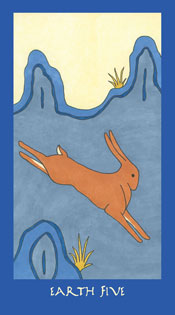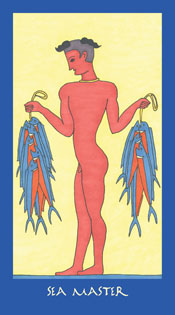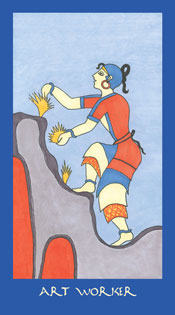

|
|
|
|
|---|---|---|

|
I need to state up-front that Ellen Lorenzi-Prince is a dear friend. More than that, she gave me her copy of the Minoan Tarot as a gift months before the deck was released to the public. So it would make sense that I would not
necessarily be an objective reviewer for the deck.
However, my life is often in conflict because I am, innately, in my soul, a reviewer. I look at the world, at myself, and my dearest friends with a lethally critical mind, and I’ve injured people’s feelings despite all the tact in the world that I can employ, simply because I analyze everything with an honesty that does not allow me to see a naked Emperor as clothed or a beloved person as always being correct. I am even more ruthless when addressing my own flaws or biases. More importantly, I consider reviewing a sacred practice. I am in service to those who read what I write and I recognize that their funds are often limited. I must tell them the truth as I see it, as entertainingly and effectively as I can, or I must stop writing reviews. It’s as simple (and complex) as that. So you can pretty much trust my reviews to tell the truth and shame the devil (or annoy/piss off a friend.) Enough about me, because it goes against the nature of the Minoan culture to be self-involved. Minoans “did not exalt kingship, war, nor death.” It was a goddess-centered culture which “celebrated . . . the beauty of the natural world and their own sexuality and creativity.” They were technologically advanced and art flourished. Yet that didn’t make them wusses: “The Minoans were not a warlike nation, but this did not make them weak or abject in any way.” They liked sports and taught their children to compete fairly, “with respect for . . . competitor[s] and for the rules of the game.” What is amazing about this society is that, unlike Atlantis, it existed and thrived for over a thousand years. I am sure you are thinking to yourself, “We could learn a lot from this world.” Indeed we could. But this is a tarot deck, not a history lesson—so why did I crave this deck as I have no other? Because as readers, we try to set forth a paradigm for ourselves and our clients that heals and improves our lives. The Minoan Tarot broadens our understanding, yes, but most importantly assists us in creating a healthy, creative world and worldview for ourselves and our clients. Each card expands possibilities, instead of sealing us into our tired old rubrics. Here are two examples utilizing cards that are traditionally viewed as challenging: The Tower has been renamed “Shipwreck” in the Minoan Tarot. Threats at sea were a danger with which the Minoans had to contend. These perils were met with bravery and resourcefulness, but highlighted the impermanence and fragility of life. Yes, things were rebuilt, but some things can not be resurrected. That is the interpretation for this card, along with those messages: Relinquish your interest in this prospect and start over. Troubles are more easily endured when you decide to be brave. Great powers are at work around you. Don’t take it personally, because they are not. If we look at traditional interpretations for this card, they frequently focus on the impending disaster. You are not exhorted to be brave or reminded that “this isn’t about you.” The emphasis is on the calamity, not how to contend with or meet it. Now we will move on to the “nightmare” card, the Nine of Swords. In the Minoan Tarot, Swords are Sky, and Sky Nine depicts three pillars topped with doves. The pillars are a Minoan symbol of the epiphany of the Goddess, much like a tree reaches for the heavens. Doves were utilized for many things in the Minoan culture, including navigation. In this card, they can be seen as a guide for a yearning, lost soul. The messages: You are in a magical place. Cast a spell or say a prayer. Be present. Within a vast cosmos, you are unique. Make your home a place of peace and beauty. Again, we can see this card with its full force, yet not be immured in a torment-tossed bed. This is an important distinction. I despise decks that are the equivalent of cardboard lollipops or gloss over the difficult cards with a smiley-face. The Minoan Tarot, like its Minoan forebears, acknowledges the perils but addresses them with “bravery and resourcefulness.” And so much spirit! You can see how this deck would be helpful for anyone in a dark place. Not because it is uniformly sunny (Goddess forfend!) but because it is spiritually bracing. That particular combination is exceedingly rare, hence my long-term, intense desires for this deck. The Minor Arcana suits are the “great powers” of the Minoans: Art (Wands), Sea (Cups), Sky (Swords) and Earth (Pentacles/Disks). The Court Cards are Worker, Priestess, Master, and Mistress, but do not form a direct equivalent to the traditional courts. The Worker “relates with the energy of the suit in a physical/practical way”; The Priestess “expresses spiritual direction/action.” The Master and the Mistress are “aspects of the God and Goddess” in their particular suit or “power.” All of the artwork for this deck is derived from extant Minoan art and relics. While the Minoan Tarot is the third 78-card deck published by Lorenzi-Prince, it was completed after her first deck, Tarot of the Crone, but prior to the Dark Goddess Tarot. As a result, it is artistically more accomplished than the Tarot of the Crone, but less refined than the Dark Goddess Tarot. The month of September was a particularly contentious and demanding one for me. I chose the Minoan Tarot as my deck for my Card of the Day readings and, looking back over my entries, I am amazed at how balanced and philosophical my attitude was during this time. I have to believe that the Minoan Tarot heavily contributed to my sanity. I did quote the author directly at times, but here are some examples of my Twitter entries: Sea Master Balance giving to myself/others. Developing organizational mastery. Chopping wood, carrying water. Art Worker What a long strange trip it's been...the most tiring and the most exciting, all in one day. One long day. World Tree Physically fragile today, yet so much I must do. Been here before, done that, so can do it again. Accepting. Earth 5 Quick like a bunny today--much chopping of wood, carrying of water. Scattershot approach and keen awareness for the win. Keep in mind that this was an unbelievably stressful time. I acknowledge the stresses, but I am . . . dare I say it? Strong and resourceful. Despite the stresses. I attribute that resilience and philosophical calm to the influence of the Minoan Tarot. The version available for purchase comes in a glossy, heavy cardboard box with a top and bottom (as opposed to a fold-in top). While it isn’t as simple to open as a fold-in, it’s much more durable and will provide a protective shelter for your cards for your lifetime (unless you pour water over it or something). A not-quite 100 page full-color illustrated companion booklet (with a foreword by - Rachel Pollack ) includes a bit of Minoan history, card descriptions and “messages” from each card, and two unique spreads and sample readings, along with some recommended “Further Reading.” The cards are significantly longer and slightly wider than a standard tarot deck, which adds to the simple power of the images. The cards have a bluish-purple border which sets the artwork off nicely. Occasionally, the background flows into the border because they share a color (V Singer, XV Ecstasy, XXI World Tree, Earth Mistress). I love this effect! The non-reversible card backs feature a labrys (double-headed ceremonial axe not used for warfare) against a red background. The quality of the set is impeccable—another feather in the cap of Arnell Ando’s company for self-publishing. I recommend this tarot deck for those who are advanced enough in their studies to want to expand, as opposed to memorize. This is not a good deck to give to someone who wants to “learn tarot.” It’s a great deck to give to someone who wants to live with strength and resourcefulness, hope and creativity, possibility and spirit. If that includes giving it as a present to yourself, so much the better.
|


|
|
|
Minoan Tarot is copyright protected. Card images may be used on blogs/websites as 'Card of the Day' endeavors or for review purposes but must contain the website along with Minoan Tarot by Ellen Lorenzi-Prince. The images are not to form part of written teaching materials or otherwise be used without prior consent from the artist. | |
|
|
Home · Tarot of the Crone · Dark Goddess Tarot · Minoan Tarot · Arts & Artifacts · Contact | |
|
This site designed & maintained by Arnell's Art |